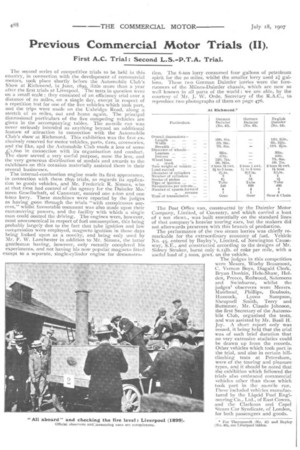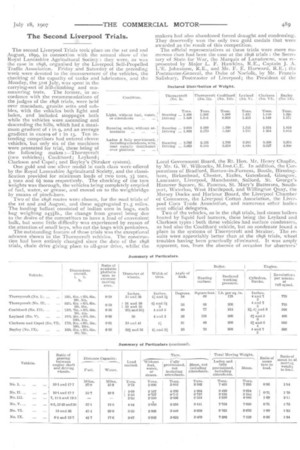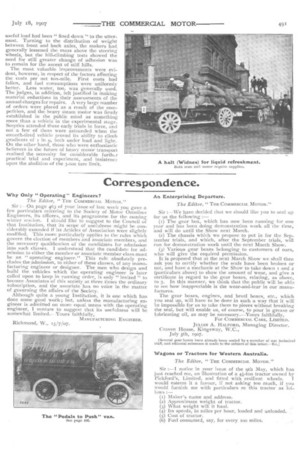Previous Commercial Motor Trials (H).
Page 18

Page 19

Page 20

Page 21

If you've noticed an error in this article please click here to report it so we can fix it.
First A.C. Trial : Second L.S.-P.T.A. Trial.
The second series of competitive trials to be held in this country, in connection with the development of commercial motors, took place shortly before the Automobile Club's Show at Richmond, in June, 1899, little more than a year after the first trials at Liverpool. The tests in question were on a small scale : they consisted of an efficiency trial over a distance of 20 miles, on a single day, except in respect of a repetition test for one of the five vehicles which took part, and the trips were made on the Uxbridge Road, along a stretch of to miles, out and home again. The principal dimensional particulars of the five competing vehicles are given in the accompanying tables. The 20-mile run was never seriously intended as anything beyond an additional feature of attraction in connection with the Automobile Club's show at Richmond. This exhibition was the first exclusively reserved for motor vehicles, parts, tires, accessories, and the like, and the Automobile Club made a loss of some .4:1,600 in connection with its organisation and conduct. The show served a very useful purpose, none the less, and the very generous distribution of medals and awards to the exhibitors on this occasion materially assisted them in their several businesses.
The internal-combustion engine made its first appearance, in connection with these 1899 trials, as regards its application to goods vehicles, and Mr. Frederick R. Simms, who at that time had control of the agency for the Daimler Mo-' toren Gesellschaft, of Cannstatt, entered one 2-ton and one 6-ton lorry. These machines were reported by the judges as having gone through the trials "with conspicuous success," whilst favourable oomment was also made upon their manceuvring powers, and the facility with which a single man could control the driving. The engines were, however, most uneconomical in respect of fuel consumption, this being probably largely due to the fact that tube ignition and low compression were employed, magneto ignition in those clays being looked upon as a novelty, and being only used by Mr. F. W. Lanchester in addition to Mr. Simms, the latter gentleman having, however, only recently completed his experiments, and not having his now popular magneto fitted except to a separate, single-cylinder engine for demonstra tion. The 6-ton lorry consumed four gallons of petroleum spirit for the 20 miles, whilst the smaller lorry used 4 gallons. These two German Daimler lorries were the forerunners of the Milnes-Daimler chassis, which are now so well known in all parts of the world : we are able, by the courtesy of Mr. J. W. Orde, Secretary of the R.A.C., to reproduce two photographs of them on page 476.
The Post Office van, constructed by the Daimler Motor Company, Limited, of Coventry, and which carried a load of i ton .t6cwt., was built essentially on the standard lines of that company's heavier touring cars, but the makers did not afterwards persevere with this branch of production.
The performance of the two steam lorries was chiefly remarkable for the extraordinary economy of fuel. Vehicle No. 4s, entered by Bayley's, Limited, of Newington Causeway, SE., and constructed according to the designs of Mr. Sidney Strakcr, burnt only 6.151b. of coke per mile, with a useful load of 3 tons, scwt. on the vehicle. The judges in this competition were Messrs. Worby Beaumont, C. Vernon Boys, Dugald Clerk, Bryan Donkin, Hele-Shaw, Holden, Preece, Redwood, Salomons and Swinburnc, whilst the judges' observers were Messrs. Muirhead, Phillips, Boulnois, Hancock, Lyons Sampson, Shrapnell Smith, Terry and Buttemer. Mr. Claude Johnson, the first Secretary of the Automobile Club, organised the tests, and was assisted by Mr. Basil H. Joy. A short report only was issued, it being held that the trial was of such brief duration that no very extensive statistics could be drawn up from the records. Other vehicles which took part in the trial, and also in certain hillclimbing tests at Petersham, were of the touring and pleasure types, and it should be noted that the exhibition which followed the trials also embraced commercial vehicles other than those which took part in the 20-mile run. These included vehicles manufactured by the Liquid Fuel Engineering Co., Ltd., of East Cowes, and the Clarkson and Cape! Steam Car Syndicate, of London, for both passengers and goods.
Light, without fuel, water, or attendants Running order, without atteudants Laden & fully provisioned, ( including attendants, with load equally distributed over platform The second Liverpool Trials took place on the ist and 2nd August, 1899, in connection with the annual show of the Royal Lancashire Agricultural Society : they were, as was the case in 1898, organised by the Liverpool Self-Propelled Traffic Association. Friday and Saturday of the preceding week were devoted to the measurement of the vehicles, the checking of the capacity of tanks and lubricators, and the Monday, the 31st July, was spent in the carrying,-out of hill-climbing and ma
rimuvring, tests. The former, in accordance with the recommendations of the judges of the 1898 trials, were held over macadam, granite setts and cobbles, with the vehicles both light and laden, and included stoppages both while the vehicles were ascending and descending the hills, which had a maximum gradient of i in g, and an average gradient in excess of i in /3. Ten intending competitors had entered eleven vehicles, but only six of the machines were presented for trial, these being of the following makes :-Thornycroft (two vehicles); Coulthard; Leyland; Clarkson and Capel ; and Bayley's (Straker system).
One gold and one silver medal in each class were offered by the Royal Lancashire Agricultural Society, and the classi fication provided for minimum loads of two tons, tons, 5 tons and 4 tons respectively. The checking of the tare weights was thorough, the vehicles being completely emptied of fuel, water, or grease, and moved on to the weighbridge by means of pinch-bars.
Two of the 1898 routes were chosen, for the road trials of the 1st and 2nd August, and these aggregated 71.5 miles. The loading ballast consisted of indian corn in bags, each bag weighing 2430b., the change from gravel being due to the desire of the competitors to have a load of convenient bulk, but some little difficulty was experienced by reason of the attention of small boys, who cut the bags with penknives.
The outstanding feature of these trials was the exceptional advance shown in the Thornycroft vehicles. The construction had been entirely changed since the date of the 189S trials, chain drive giving place to all-gear drive, whilst the Condition. makers had also abandoned forced draught and condensing. They deservedly won the only two gold medals that were awarded as the result of this competition.
The official representatives at these trials were more numerous than had been the case at the 180 trials : the Secretary of State for War, the Marquis of Lansdowne, was represented by Major L. F. Hawkins, R.E., Captain J. A. L'E. Johnstone, R.E., and Mr. F. E. Harward, R.E. ; the Postmaster-General, the Duke of Norfolk, by Mr. Francis Salisbury, Postmaster of Liverpool; the President of the
Local Government Board, the Rt. Hon. Mr. Henry Chaplin, by Mr. G. W. Willcocks, M.Inst.C,E. In addition, the Corporations of Bradford, Barrow-in-Furness, Bootle, Birmingham, Birkenhead, Chester, Eccles, Gateshead, Glasgow, Lancaster, Liverpool, Manchester, Salford, St. George's Hanover Square, St. Pancras, St. Mary's Battersea, Southport, Waterloo, West Hartlepool, and Willing-ton Quay, the Mersey Docks and Harbour Board, the Liverpool Chamber of Commerce, the Liverpool Cotton Association, the Liverpool Corn Trade Association, and numerous other bodies sent official delegates.
Two of the vehicles, as in the 1898 trials, had steam boilers heated by liquid fuel burners, these being the Leyland and Clarkson types : both these vehicles had surface condensers, as had also the Coulthard vehicle, but no condenser found a place in the systems of Thornycroft and Straker. The results were appreciably better than at the 1898 trials, wheel troubles having been practically eliminated. It was amply apparent, too, from the absence of occasion for observers'
notes, that the mechanical portions of the machines had been considerably improved during the interval of one year ; in fact, SO few mishaps occurred on the road, that it is unnecessary to reproduce the notes from the log-sheets, which notes were of a voluminous character in the 1898 trials (see pages 468 and 4691 of last week).
The judges' conclusions set forth the general superiority of the vehicles compared with those submitted for trial in 1898, and pointed out that it seemed necessary, where work had to be conducted over roads similar to those traversed during the trials, and at speeds of from five to six miles per hour, to allow about ts per cent. per annum for depreciation. They suggested still better and more thorough attention to Lock-nuts, collars, split pins, and the effective keying of wheels, in the belief that such expenditure might prevent breakdowns of an annoying character. They reiterated their belief that. the imperfections of common roads were the principal causes of the heavy depreciation and maintenance charges, and of whatever clement of uncertainty attaches to any service of motor vehicles. On the subject of manceuvring, they were of opinion that the competing vehicles were able to work into and out of embayments of one and a half times their own lengths, and to draw up close to arid parallel with the wall of the bay, and that the vehicles were capable of going anywhere that horse-drawn vehicles are ordinarily required to go. They pointed out that the hill-climbing tests had demonstrated that the powers of the competing vehicles in this direction were greatly superior to those of horse-drawn vehicles, and they directed attention to the important question of increased adhesion, to which end they recommended manufacturers to put more weight upon the driving axle. They adhered to their view, arrived at in the first report, that " at least two speed gears, or an equivalent reserve of player, are essential to successful working," and they reported that liquid fuel was at a serious disadvantage, compared with solid fuel, and more particularly with coke, where costs per net ton miles are a determining factor. On the subject of condensers, the judges pointed out that, where water is easily obtainable at points not more than
590 640 400 Thoruyeroft (Nc.1).
Thornycroft (No. II).
Coultheml (No. III), Leyland (Na, V). 450 Clarkson (No. VI). 450
Bayley
(No. IX). 603
15 miles apart, it is questionable if a condenser is of any advantage, unless its efficiency is very high, and they noted that the vehicles using condensers did not lubricate their cylinders. They reported, on the subject of performance, that four tons of load, carried on the legal tare of three tons, at the legal speed of five miles an hour, was the maximum performance that had so far been obtained satisfactorily, by a four-wheeled motor vehicle, but they pointed out that " the present small area of wheel contact is a serious, difficulty in the problem of goods transport by motor vehicles, and constitutes probably the chief mechanical cause of the slow progress made." They repeated the unanimous view of the judges of the 1898 trials, as to its being highly desirable to increase the tare weight, both in the interests of proper economy and efficiency, and for the safety of the public and in their interests. Proceeding from this point, the judges intimated their strong views that the requirements of trade in large manufacturing and distributing centres "cannot be met with the load limit of four tons, which these and the previous trials clearly indicate as the working maximum," and they conclude by stating that it was clear to them that the heavy motor-wagon industry could not, in this country, attain its legitimate proportions until the restrictions then in force were modified so as to enable manufacturers to supply vehicles capable of carrying loads of the same weight and bulk as those now drawn by horses.
For the sake of comparison with the corresponding results of the 1898 trials, we publish tables which will be found to correspond with those given last ' week. A study of these discloses the directions in which' advances were made between May, t898, and August, 1899. Wheel diameters had been slightly increased; angles of lock had been reduced by about 3 degrees on the average; the heating-surfaces of the boilers had gone up by nearly 25 per cent. ; working pressures were a little greater, and engine r.p.m. had been augmented, obviously to get the maximum power without appreciably greater weight ; the gear ratios all showed a greater range of leverage between crankshaft and driving wheels ; a marked rise in the distance capacities, both for the water and fuel carried, was demonstrated ; and the ratios of mean tare to useful load had been " fined down "to the uttermost. Turning to the distribution of weight between front and back axles, the makers had generally lessened the mass above the steering wheels, but the hill-climbing tests showed the need for still greater change of adhesion was to remain for the ascent of stiff hills.
The most valuable improvements were evident, however, in respect of the factors affecting the costs per net ton-mile. First costs had fallen, and fuel consumptions were uniformly better. Less water, too, was generally used. The judges, in addition, felt justified in making material reductions in their assessments of the annual charges for repairs. A very large number of orders were placed as a result of the competition, and the heavy steam motor was firmly established in the public mind as something more than a vehicle in the experimental stage. Sceptics attended these early trials in force, and not a few of them were astounded when the smooth-tired vehicle proved its ability to climb gradients of x in 9, both under load and light. On the other hand, those who were enthusiastic believers in the future of heavy motor transport realised the necessity for considerable furth,r practical trial and experiment, and insistence upon the abolition of the 3-ton tare limit.


























